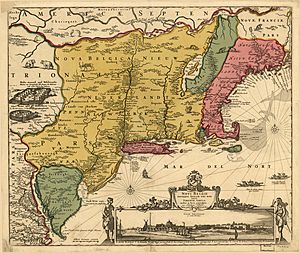Plantations of New England facts for kids
The Plantations of New England were early settlements made by Europeans on the east coast of North America. This area became known as New England.

The name New England was first used very early on. In 1616, Captain John Smith wrote about the area in a pamphlet. The name became official in 1620. This happened when King James I gave a special permission to the Plymouth Council for New England.
Later, the land was split into smaller areas. For example, in 1629, a royal grant was given for "Hampshire." This was for "making a Plantation & establishing of a Colony or Colonyes in the Countrey called or knowen by ye name of New England in America."
Farms in New England were not as big or important as those in the Southern colonies. The soil in New England was often rocky and not great for large-scale farming.
Contents
Farming in Early New England
Native American Farming Methods
People were already farming in New England before European settlers arrived. Native Americans in southern New England had a well-organized way of growing food. Their main food was corn (maize). They planted corn in small hills in clearings they made in the woods.
Farming was less common in northern New England. This was because the growing season was shorter there. People in the north mostly hunted, fished, and gathered wild berries and nuts. In southern New England, Native Americans also grew beans, squash, and pumpkins alongside their corn. They also grew some tobacco, though not as much as in the Southern colonies. Other crops included melons and strawberries.
Native American farmers used their fields for about five years. After that, they would let the land rest and turn back into woodland. This happened quickly because forests grow fast in New England. Women usually did most of the farm work. Men were more involved in growing tobacco.
European Settlers and Land Use
When European settlers came, they found lots of untouched land. They wanted to use it like farms in England. The settlers brought their own farming methods. They cleared large areas to create farms.
However, farms in New England were usually small. They were mainly for growing food for the families who lived there. They were not like the huge farms in the South that grew crops for profit.
The English farming methods were not always good for New England's soil. By the early 1800s, much of the land was worn out. This led to new ways of farming. People started using science to make farming more efficient and sustainable.
Factories, Railroads, and Farming
Between 1800 and 1900, many factories and new towns grew in New England. This changed farming a lot. Factories needed raw materials and more food for their workers. At first, farmers could not keep up with this new demand.
But by 1840, railroads began to develop. This made it much cheaper to transport goods. Farms in New York and other areas could now send their crops to New England easily. This created a lot of competition for New England farmers.
To compete, New England farmers had to make their farms more efficient. They started using new technologies and investing more in their land. These changes were difficult, but they led to what people called an "agricultural revolution" in the region.
Other Northern Farms
While New England had many farms, other Northern colonies also had large farming industries. For example, New York and other Mid-Atlantic Colonies had important agricultural areas. One well-known farm in New York was the Montskill Estate.
Conclusion
Farming in New England changed a lot over time. It played a key role in making sure people had enough food. Farmers also found ways to make a profit. They used new technologies as they became available.

